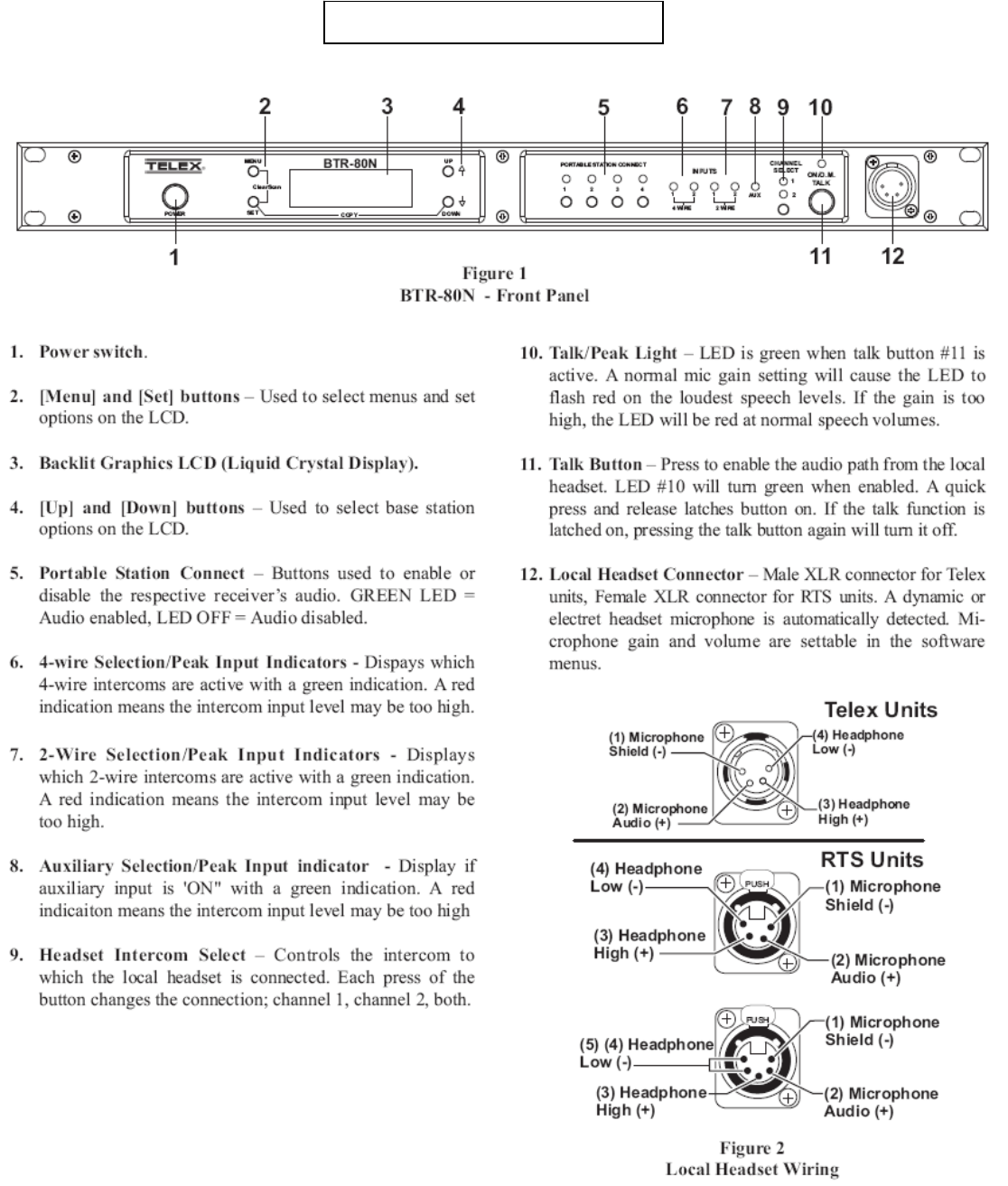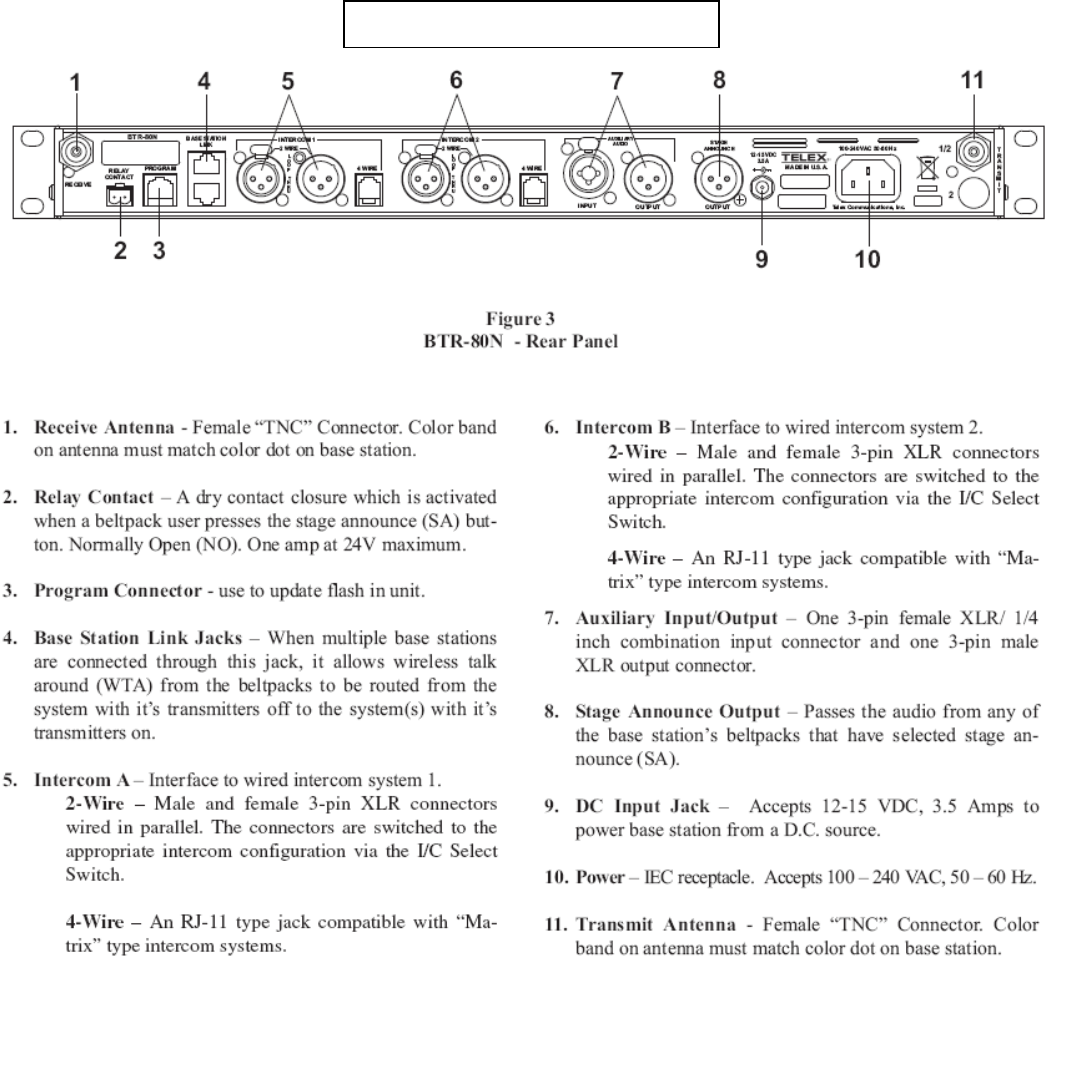Bosch Security Systems M528 Wireless Radio Base Station User Manual Telex Model TR 1 Beltpack
Bosch Security Systems, Inc. Wireless Radio Base Station Telex Model TR 1 Beltpack
user manual
Telex Model BTR-80N Base Station
Owners / Users Manual
(Preliminary Information)
General Description:
The Telex model BTR-80N base station transceiver is
a component of the BTR-80N wireless intercom
system. The BTR-80N is a rack mountable, full
duplex, wireless intercom radio for use in a
professional installation such as television or cinema
production.
Each BTR-80N base station can be used with one to
four TR-80N or TR-82N beltpacks. The BTR-80N
transmits within the 482 to 608 MHz range (TV
Channels 16-36). It receives in the 614 to 722 MHz
range (TV Channels 38-55). The BTR-80N
transmitters operate within an 18 MHz wide section of
the transmit frequency range. The receiver also
operates with a single front-end that is 18MHz wide
and then block down-converts the received frequencies
to four IF strips.
The RF coverage range of the BTR-82N
communicating to beltpacks may be up to 200 meters
(656 ft).
The transmitters have three selectable conducted
output power levels; Off, 10mW, 50mW, 100mW and
249mW. This user selectable power level allows
intermodulation reduction plus the lower of transmit
power to just meet the communication link’s need.
Operating frequencies can be selected from pre-set
groups or the user can select special operating
frequencies within the 18 MHz wide allotments.
From the front panel LCD display and buttons the
following menus may be obtained:
• Group and Channel
• Transmit Frequencies
• Receive Frequencies
• Volume and Microphone Gain Setting
• Transmit power level (Off, 10mW, 50mW
100mW, 249mW)
• Receiver Squelch Level
• Intercom type
• Intercom input/output levels
• Auxiliary input/output levels
• Stage announce output level
The on/off control, talk button, talk light, low battery
indicator, microphone overmod. light, audio channel 1
or 2 button and lights, auxiliary and intercom level
indicator lights, portable station connection buttons
are all on the front panel.
The BTR-80N base station can be powered by 100 –
240 VAC, 50 – 60Hz, via an IEC receptacle. The unit
may also be powered via a 12 - 15VDC receptacle on
the rear panel.
Page 1 of 5

Controls and Connections
Page 2 of 5

Controls and Connections
Page 3 of 5

Specifications:
General:
Input Power………………………………………….……..100-200 VAC, 50 – 60 Hz, IEC receptacle
Antennas……………………………………………………one TX, one RX: 1/2-wave, TNC male connector
TX / RX………...Two TX, one RX with 4 IF strips. Frequency agile, 25kHz steps within 18MHz wide allotments
Frequency Range……………………………………………TX…………….482 – 608 MHz
RX…………….614 – 722 MHz
(within 18MHz wide allotments)
FCC ID:……………………………………………………..B5DM528
IC ID:……………………………………………………….1321A-BTR80N
Transmitter:
RF Power Output……………Selectable between levels: Off, 10mW, 50mW, 100mW, 249mW typical (terminated)
Final Voltage (249mW)……………………………………..4.75 VDC
Final Current (249mW)……………………………………..57mA
Modulation type………………………………………….….FM
Deviation…………………………………………………….5 kHz
Audio Frequency Response…………………………………100 Hz to 7 kHz
Microphone Sensitivity ………………………………..……15 mV
Receiver:
Sensitivity……………………………………………………<0.6uV for 12 dB SINAD Typical
Audio Frequency Response…………………………………..100 Hz to 7 KHz
Audio Output (headset)…………………………………….….40 mW, 600 Ohms (1% Distortion)
RF Frequency Stability…………………………………….….Better than 0.005%
IF Selectivity……………………………………………….....3 dB at 30kHz
Approval Information:
FCC
The Telex BTR-80N Transmitter/Receiver base station is type accepted under United States Federal
Communications Commission Part 74.
This device complies with Part 15 of the FCC Rules. Operation is subject to the condition that this device
does not cause harmful interference.
Licensing of Telex equipment is the users responsibility and licensability depends upon the user’s
classification, user’s application and frequency selected. Telex strongly urges the user to contact the
appropriate telecommunications authority for any desired clarification.
CAUTION: Any changes or modifications made to the above equipment could void the user’s authority to
operate the equipment.
Page 4 of 5
Safety Instruction to Base Station Installers and Users
1. Use only manufacturer or dealer supplied antenna. Antenna minimum safe distance, as calculated
from the FCC requirements, is 9.4cm. However, the FCC default for the minimum safe distance is
20cm. Antenna gain: 1.5dBi.
2. The FEDERAL COMMUNICATIONS COMMISSION has adopted a safety standard for human
exposure to RF (Radio Frequency) energy, which is below the OSHA (Occupational Safety and
Health Act) limits.
3. To comply with current FCC RF Exposure limits, the antenna must be installed at or exceeding the
minimum safe distance show here, and in accordance with the requirement of the antenna
manufacturer or supplier.
4. Antenna substitution: Do Not substitute any antenna for the one supplied by or recommended by
the manufacturer or radio dealer. You may be exposing person or persons to harmful radio
frequency radiation. You many contact your radio dealer or the manufacturer for further
instructions.
5. WARNING: Maintain a separation distance from the antenna to person(s) of at least 20cm.
You, as the qualified end-user of this radio device must control the exposure conditions of
bystanders to ensure that the minimum separation distance (above) is maintained between the
antenna and nearby persons for satisfying RF exposure compliance.
The operation of this transmitter must satisfy the requirements of the General
Population/Uncontrolled Exposure Environment for work-related use. Transmit only when
person(s) are at least the minimum distance from the properly installed, externally mounted antenna.
Industry Canada
The Telex BTR-80N Transmitter/Receiver base station is Certified to Industry Canada RSS-123 rules.
Licensing of Telex equipment is the users responsibility and licensability depends upon the user’s
classification, user’s application and frequency selected. Telex strongly urges the user to contact the
appropriate telecommunications authority for any desired clarification.
CAUTION: Any changes or modifications made to the above equipment could void the user’s
authority to operate the equipment.
Page 5 of 5